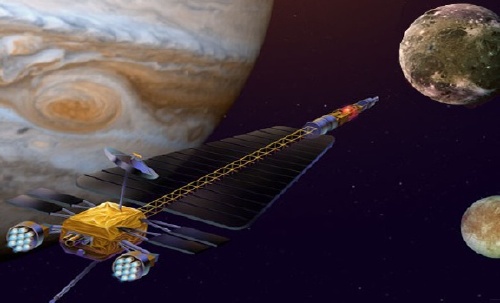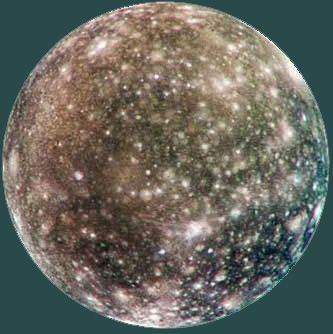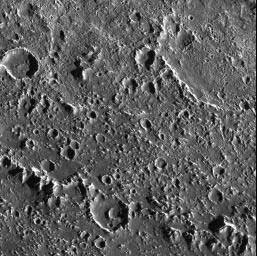 |
|||||
|---|---|---|---|---|---|
| EXPLORING THE JUPITER SYSTEM | |||||
| Jupiter | Moons | Oceans | Volcanos | Rings | Radio |
| JIMO | Galileo | Cassini | Pioneer | Voyager | Resources |
The Jupiter Icy Moons Orbiter:
The Cratered Moon Callisto
Craters, craters, craters everywhere!
Jupiter's moon Callisto
Callisto is the most heavily cratered satellite in the Solar System.
It is the second largest natural satellite of Jupiter and the third largest moon anywhere in the Solar System. In fact, Callisto is so large it is about the same size as the planet Mercury. MOON DIAMETERS
Callisto's orbit is located just outside of Jupiter's main radiation belt.
The moon's crust is very ancient, dating back some four billion years to a time just shortly after the Solar System formed around our star, the Sun.
Callisto will be the first Jupiter moon explored by the Jupiter Icy Moons Orbiter.
The surface. Callisto does not have any large mountains, probably because of the icy nature of its surface.
In fact, impact craters and the concentric rings around them are about the only features seen on Callisto.
The larger craters have been erased by the flow of the moon's icy crust over time. Two enormous concentric ring, impact basins can be seen on Callisto:Beneath the surface. Data returned to Earth from the Galileo spacecraft suggests the surface of Callisto is atop a 124-mile-thick crust. Scientists think there may be a salty ocean six miles beneath the surface. Beneath the ocean, the interior of the moon is not uniform, but does vary dramatically.
- The larger, named Valhalla, has a bright central region that is about 373 miles in diameter. Its rings extend out to a diameter of 1,864 miles.
- The second largest impact basin is Asgard, which measures some 994 miles in diameter.
Before they sent the Galileo probe for a closer look, scientists had thought that Callisto's interior was completely uniform. Galileo change their minds when its data suggested the interior is composed of compressed rock and ice with the percentage of rock increasing as depth increases.
Small bodies, something like the meteorites that strike Earth, may have punched holes in Callisto's crust over the eons, causing water to spread over the surface and form bright rays and rings around the crater.
Callisto probably does not have an atmosphere.
A view of the surface. The NASA photo at right of the surface of Jupiter's icy moon Callisto was snapped in 1997 by the Galileo spacecraft from a distance of 5,700 miles. The image covers an area 50 by 55 miles. The resolution is about 295 feet per picture element.
Surface of the moon Callisto
click to enlarge Galileo image
Callisto's surface shows a transition from the inner part of an enormous crater, known as Asgard, to the outer surrounding plains. Small, bright, fine textured, closely spaced bumps appear throughout the inner part of the impact basin, top, and create a more fine textured appearance than that seen on many of the other plains inside craters on Callisto.
The icy bumps make Asgard's center brighter than the surrounding terrain. What caused the bumps to form is unknown, but they are associated with the impact that formed Asgard.
The ridge at lower left center cuts diagonally across one of many giant concentric rings that extend for hundreds of miles outside Asgard's center.
Outside of the ring, lower left corner, Callisto's surface changes significantly. Still peppered with craters, the number of icy bumps decreases while their average size increases. The fine texture is not as visible in the middle of the image.
It may be that material from raised features, such as the ridge, slide down slope and cover small features. Callisto photos help us understand giant impacts on icy surfaces, and how large structures change with time.
Source: NASA Jet Propulsion Laboratory
Diameters of the Largest Satellites and the Planets miles miles Mercury 3,031 Saturn 74,901 Venus 7,521 Titan 3,200 Earth 7,927 Rhea 949 Moon 2,160 Iapetus 892 Mars 4,222 Dione 696 Jupiter 88,848 Tethys 650 Ganymede 3,274 Uranus 31,765 Callisto 2,986 Titania 981 Io 2,256 Neptune 31,404 Europa 1,945 Triton 1,678 Pluto 1,440 Charon 790
Learn more about Jupiter and its moons and rings:
Solar System Search STO STO cover Questions Feedback Suggestions © 2004 Space Today Online

